In 2021, the cultural intangible heritage connected to hay was included in the National Inventory of Intangible Heritage in Romania, with the title “The Culture of Hay: knowledge and traditional practices concerning hay harvesting in semi-natural meadows, in the mountain and sub-mountain areas of Carpathians Mountains”. It is a complex document, including the description of knowledge and tasks carried out to have a good harvest of the hay, together with historical and geographical information.
The importance of including traditional ecological knowledge associated with hay production on the National Inventory List is stressed by the fact that in Romania this knowledge is still in use in many regions. People still have little plots of hay meadows in use, as they need to produce winter fodder for the animals they have. It is true that in many regions (especially in the plain and plateaux areas, and partially also in the mountain regions, where the landscape allows) working with hay has been mechanized. For example, the grass is cut with mowing machines (see image 1), and tractors are also used to cut the grass, as well as to make hay-bales.

This mechanization will help the people work more easily, and faster, but, at the same time, it will mean the disappearance of a specific landscape, typical especially in the mountain and hilly areas, where different shapes of hay construction are placed all over the fields and for long periods of time, sometimes also during winter. It is a cultural landscape (see images 2 and 3) that is threatened and forced into disappearance.


Attention has been drawn to this traditional knowledge by researchers, mainly in the field of Biology and Ecology, but who are also working with anthropologists, as their studies acknowledge the strong connection between the rich biodiversity and the diversity of practices. For example, such recent studies for the Romanian area are: Akeroyd & Page 2006; Akeroyd & Page 2011; Dahlstöm et al. 2013; Babai & Molnár 2014; MARTOR 2016; Babai 2017; Ivașcu & Rakosy 2017; Johansen et al. 2019; Janišová et al. 2021.
The calendar of works connected to hay harvesting is complex, and covers all the seasons, not only summer, when hay is produced. People in the villages maintain the meadows by fertilizing them in winter and spring, cleaning them in the spring, grazing them in spring and autumn and mowing and hay harvesting in the summer-autumn seasons.
Cleaning of the meadows is an elaborate activity that starts early each Spring (whenever the snow melts, thus, already in March): bushes are cleared from the meadows; the plants that are considered weeds are removed (for example Rumex); in northern Romania, anthills are removed and placed on the border of the properties (see image 4); old leaves are raked; if branches from trees have fallen, they are removed.
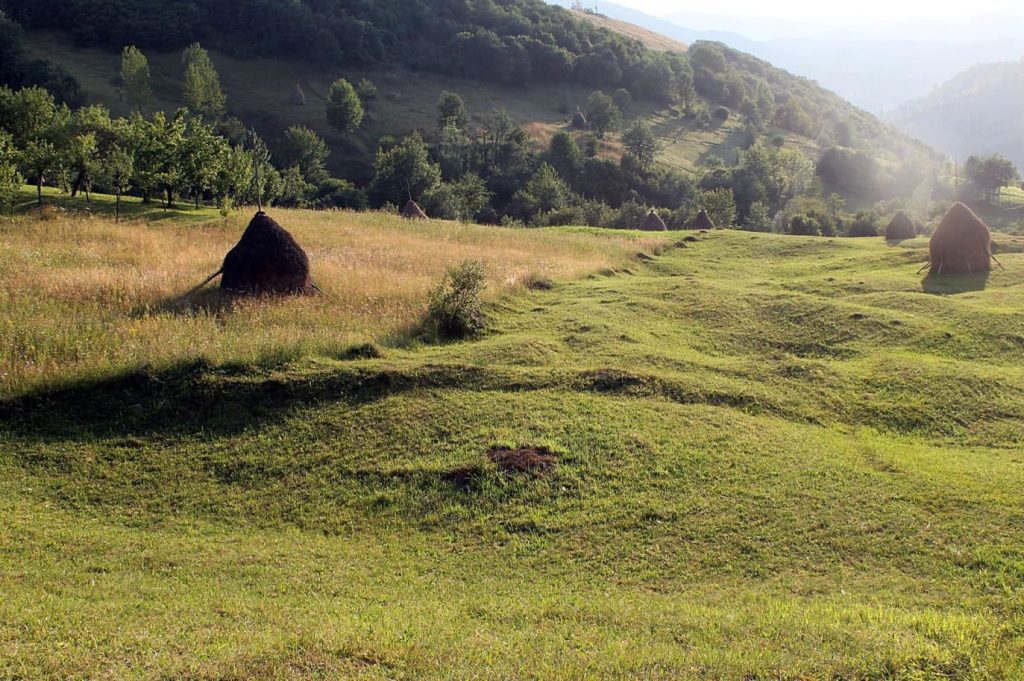
After the cleaning of the meadow, grazing on a small scale begins in April, as each owner of sheep (or goats) takes their own animals to graze their hay meadows (see image 5), until the summer farms and local pendulant transhumance can start.

Usually, grazing is allowed until the feast of St. Constantine and Helen, 21st of May, or, as villagers say, until the “closing of the meadows”. Grazing by sheep (and goats) is beneficial for the meadows, as it fertilizes the meadows, but also the twinning of grasses thus increases the quality of the hay. In the past 15 years, though, people have been selling their animals, especially sheep, and this has a direct impact on the quality of the grass and the calendar of the hay harvesting work. Fewer sheep in a village would mean that a lower number of hay meadows are grazed in spring, thus, the grass grows faster, and the mowing starts earlier than usual, to deal with the tall grasses. A decrease in the number of animals (sheep, but also cows) has a direct impact on the land, as there is a diminished need for hay, thus, some meadows are no longer mowed, but either abandoned, or left for grazing all summer long.
After the cleaning and grazing of the meadows ends, after a month and a half (approximately), mowing can start. The right time for mowing is always the best time, and the people choose it carefully, as they want to have a good harvest not only when they mow, but also the next mowing season. For this reason, they observe the plants, as the plants show them when it is the right time for mowing. A high-quality hay would be composed of many grasses and plants, and as the plants increase in number, it is considered better and better. Thus, for preserving this biodiversity, it is compulsory to adapt the activities and to mow at the right time. According to EU regulations, this would be in the second half of July, but the villagers would say that one does not know when the right time is unless he/she is observing the grass itself: when the plants have produced seeds, then is the good time for mowing, as the seeds will spread on the land. There is one plant that tells people the right time: Rhinanthus minor (called “Little rattle” in Romanian and “yellow rattle” in English). “When the little rattle rings in the grass, the mowing can start”, say villagers from different regions in Romania. Apparently, this plant is the last to provide seeds, and, when it is ripe, it makes a small rattling noise when a person is walking through the grass. Over generations, this knowledge has been passed down, providing for continuity, and ensuring good-quality hay, but also underwriting biodiversity.
Mowing usually starts at the end of June, or beginning of July, according to the rattle sound in the grass, but also according to the weather: if it is a dry year, people would wait longer for mowing, hoping for rain, but if there is a year with abundant rain, the grass would grow faster, and people will have to find windows of good weather to harvest the hay. Mowing is usually done with the scythe, the best tool to cut the grass. It needs to be sharp, and for this reason, it is sharpened by beating with a hammer (see image 6) and honed with a whetstone. The best time for mowing with the scythe is early in the morning, when the grass is wet with dew. If a mowing machine is used, the machine would work better when the grass is dry.

Once the grass is mowed, it is left to dry on the ground, and turned around several times. If rain is in sight, the grass is hung on a wooden structure to dry with the help of the wind (see image 7).

Only when it is very dry, is a haystack made (see image 8), a haystack that can stay in the fields up to 2 years, without the hay turning bad, if the haystack is well constructed.
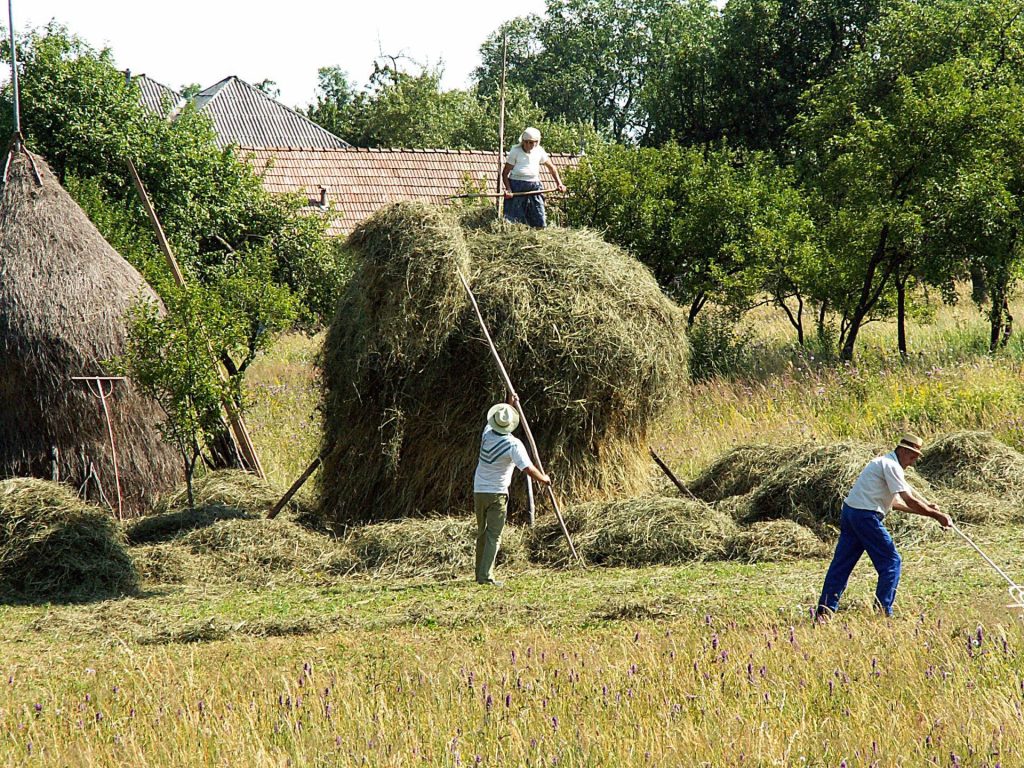
In the second half of August a second cutting of the meadows can take place, if the grass has grown enough. This second cutting is considered to be a “cookie” for the animals, a treat, as the grass is minced, and fed, usually to young animals, or to animals that are feeding the youngsters with milk.
There are also some days when it is forbidden to work with hay, all at the end of July: the feast of St. Elijah (20th of July), St. Mary Magdalen (22nd of July), St. Phocas (23rd of July), St. Ann (25th of July), and St. Pantaleon (27th July). According to local legends, people who infringed on this proscription were punished by the saints: either the haystack was hit by lightning, or a strong wind destroyed the haystacks. Several legends are still alive in the memory of the people in the mountain regions, where the weather can change during the summer rapidly and without any warning.
In the autumn, the hay is transported to the home (see image 9), to be near the barns where the animals are. Transporting the hay can also take place during the winter, when, if there is snow, it can be taken home with the sledge. Autumn is also a time for grazing the meadows, before the sheep come back to each household: thus fertilizing of the land.

Spread all over the year, the hay harvesting activities define the rural areas in Romania. As long as people still have animals in their households, the meadows will be mowed and hay will be harvested, creating typical landscapes around the villages, where the star is the haystack (see images 10 and 11).
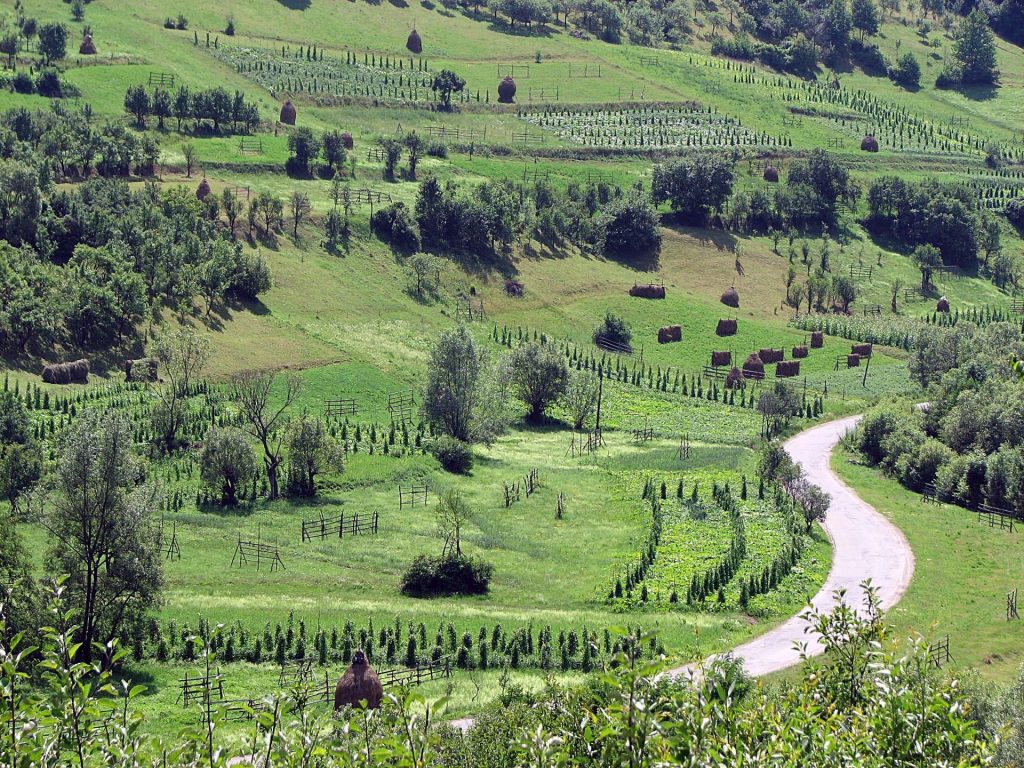
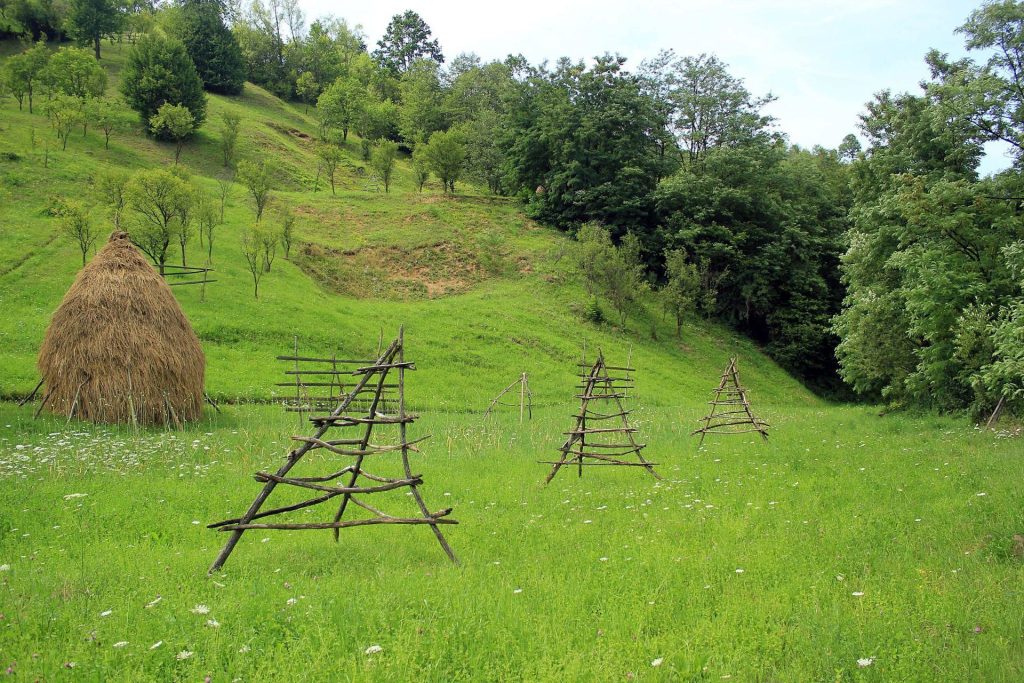
Although mechanization of agriculture is increasing, some communities still preserve and use the local knowledge, which helps them in their work, and enables them to avoid bad management of the meadows. The only problem is the aging of the local population still using this knowledge, and for this reason, heritage-making actions (local conferences, publications, exhibitions and so on) are needed, that will help the members of the community be aware that this knowledge is important and is part of the legacy their ancestors have passed on.
Bibliography:
Akeroyd, John R., Nat Page 2006, „The Saxon Villages of Southern Transylvania: Conservation Biodiversity in a Historic Landscape”. In D. Gafta, J. Akeroyd (eds.), Nature Conservation. Environmental Science and Engineering (Environmental Science), Springer, Berlin, Heidelberg, pp. 199-210.
––––––––––– 2011, „Conservation of High Nature Values (HNV) grassland in farmed landscape in Transylvania, Romania”. Contribuții botanice 46: 57-71.
Babai, Dániel 2017, „High nature value seminatural grasslands – European hotspots of biocultural diversity”. In Roué, M., Molnár, Zs. (eds.): Knowing our Land and Resources: Indigenous and local knowledge of biodiversity and ecosystem services in Europe & Central Asia. Knowledge of Nature 9. UNESCO, Paris, 71-75.
Babai, Dániel, Zolt Molnár 2014, „Small-scale traditional management of highly species-rich grasslands in the Carpathians”. Agriculture, Ecosystem and Environment 182: 123-130.
Dahlström, Anna, Ana-Maria Iuga, Tommy Lennartsson 2013, „Managing biodiversity rich hay meadows in the EU: a comparison of Swedish and Romanian grasslands”. Environmental Conservation 40 (2): 194-205.
Ivașcu, Cosmin Marius, Laszlo Rakosy 2017, „Biocultural adaptation and traditional ecological knowledge in a historical village from Maramureș Land, Romania”. In Roué, M., Molnár, Zs. (eds.): Knowing our Land and Resources: Indigenous and local knowledge of biodiversity and ecosystem services in Europe & Central Asia. Knowledge of Nature 9. UNESCO, Paris, 20-40.
Janišová, Monika, Anamaria Iuga, Cosmin Marius Ivașcu, Martin Magnes 2021, „Grassland with tradition: sampling across several scientific disciplines”. Vegetation Classification and Survey 2: 19-35.
Johansen, Line, Anna Westin, Solvi Wehn, Anamaria Iuga, Cosmin Marius Ivașcu, Eveliina Kallioniemi, Tommy Lennartsson 2019, „Traditional semi-natural grassland management with heterogeneous mowing times enhances flower resources for pollinators in agricultural landscape”. Global Ecology and Conservation 18, art. e00619, 12 p.
MARTOR. The Museum of the Romanian Peasant Anthropology Review 2016,„A Place for Hay. Flexibility and Continuity in Hay-Meadow Management” 21, 212 p.
Author:
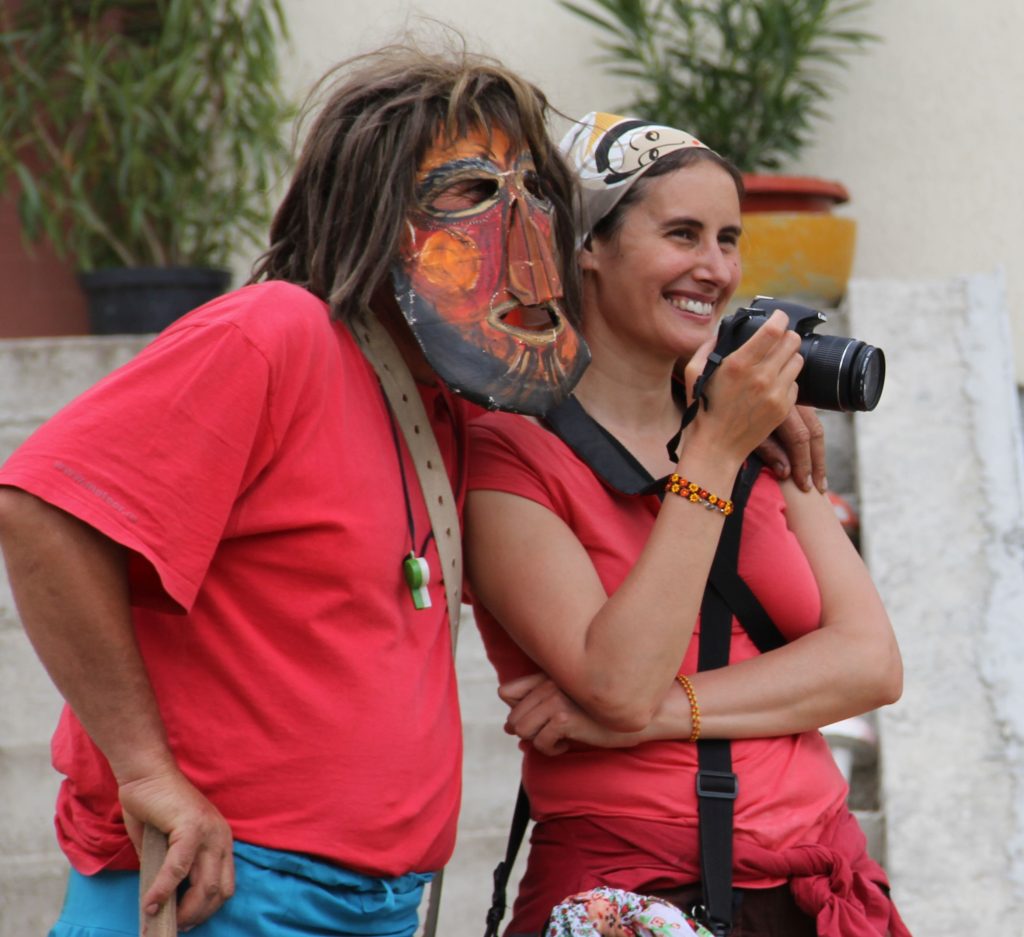
Anamaria Iuga
National Museum of the Romanian Peasant
Bucharest, Romania

